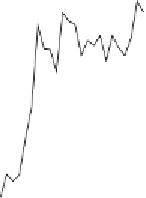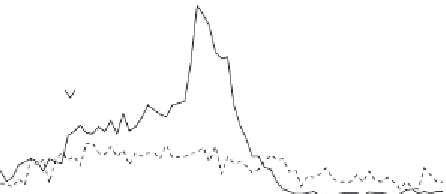Agriculture Reference
In-Depth Information
nursing position and emitting the typical grunting vocalizations (Illmann
et al.
, 1999).
However, in non-nutritive nursings, in spite of the teat stimulation, the sow does not
increase her grunting rate (Illmann
et al.
, 1999), oxytocin is not released (Ellendorff
et
al.
, 1982), milk is not ejected and therefore there is no milk intake (Fraser, 1977; Illmann
et al.
, 1999). Behaviorally, a non-nutritive nursing can be distinguished by the absence of
peak in grunting and even more reliably by the lack of piglets' rapid mouth movements
that normally occur during milk ejection (Figure 13.2).
Non-nutritive nursings are not rare exceptions and cannot be considered physiological
abnormalities or pathological disturbances. Non-nutritive nursings make up between
5% and 30% of all nursing episodes and occur with a similar average frequency in all
A
Nutritive nursing
Non-nutritive nursing
2.0
Milk ejection
(in nutritive nursings)
1.6
Start of
massage
1.2
0.8
0.4
0.0
-180
-140
-100
-60
-20
20
60
100
140
180
Time in relation to milk ejection (s)
B
1.0
Milk ejection
(in nutritive nursings)
0.8
0.6
0.4
0.2
0.0
-180
-140
-100
-60
-20
20
60
100
140
180
Time in relation to milk ejection (s)
Figure 13.2. Sow grunting rate (A) and rate of teat massaging movements by the piglets (B) in a nutritive and
a non-nutritive nursing (adapted from Illmann et al., 1999).








































